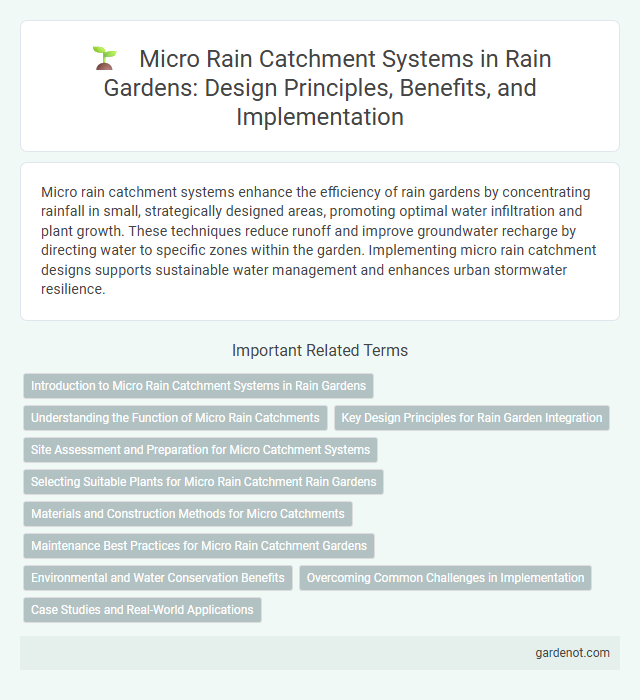Micro rain catchment systems enhance the efficiency of rain gardens by concentrating rainfall in small, strategically designed areas, promoting optimal water infiltration and plant growth. These techniques reduce runoff and improve groundwater recharge by directing water to specific zones within the garden. Implementing micro rain catchment designs supports sustainable water management and enhances urban stormwater resilience.
Introduction to Micro Rain Catchment Systems in Rain Gardens
Micro rain catchment systems in rain gardens enhance water harvesting by capturing and directing rainfall precisely to plant root zones, optimizing soil moisture and reducing runoff. These systems utilize small-scale infrastructure such as berms, swales, and infiltration basins to efficiently manage stormwater in urban landscapes. Implementing micro rain catchment technologies improves groundwater recharge and supports sustainable, low-impact landscaping practices.
Understanding the Function of Micro Rain Catchments
Micro rain catchments function by capturing and directing rainfall into designated soil areas, enhancing water infiltration and reducing surface runoff. These systems optimize water availability for plant growth by concentrating moisture around root zones, supporting sustainable landscaping and erosion control. Implementing micro rain catchments contributes to stormwater management and groundwater recharge in urban and arid environments.
Key Design Principles for Rain Garden Integration
Micro rain catchment systems optimize rain garden integration by maximizing water infiltration and minimizing runoff through strategic placement and contouring of the catchment area. Key design principles include selecting permeable soil substrates, incorporating native vegetation with high water absorption capacity, and ensuring appropriate slope gradients between 2-6% to facilitate controlled water flow. Emphasizing these elements enhances sustainable urban drainage, reduces soil erosion, and improves groundwater recharge efficiency.
Site Assessment and Preparation for Micro Catchment Systems
Site assessment for micro rain catchment systems involves evaluating soil permeability, slope, and existing vegetation to ensure optimal water infiltration and retention. Preparing the site includes clearing debris, shaping the land to direct runoff efficiently, and amending soil with organic matter to improve absorption and plant growth. Proper assessment and preparation maximize the efficiency of micro catchment systems in capturing rainwater for sustainable landscape irrigation.
Selecting Suitable Plants for Micro Rain Catchment Rain Gardens
Selecting suitable plants for micro rain catchment rain gardens involves prioritizing native species with deep root systems that enhance water infiltration and soil stabilization. Choose drought-tolerant and water-loving plants to manage variable moisture levels while supporting local biodiversity. Incorporating a diverse mix of grasses, perennials, and shrubs maximizes pollutant uptake and creates resilient micro-ecosystems for sustainable rainwater management.
Materials and Construction Methods for Micro Catchments
Micro rain catchments use materials such as permeable soil, gravel, and organic mulch to maximize water infiltration and retention. Construction methods involve creating shallow basins or pits with compacted edges and gentle slopes to direct runoff into the catchment area, ensuring efficient water absorption. Incorporating layers of sand and organic matter enhances filtration and supports plant growth within the micro catchment system.
Maintenance Best Practices for Micro Rain Catchment Gardens
Micro rain catchment gardens require regular inspection to prevent clogging in inflow and outflow structures, ensuring efficient water capture and drainage. Maintaining soil health through periodic mulching and removal of invasive weeds supports optimal plant growth and water infiltration. Seasonal pruning and debris removal enhance garden longevity and promote sustainable stormwater management.
Environmental and Water Conservation Benefits
Micro rain catchment systems enhance environmental sustainability by capturing and redirecting stormwater to gardens, reducing runoff and soil erosion. These systems promote water conservation by maximizing infiltration, improving groundwater recharge, and supporting plant growth without relying on supplemental irrigation. Integrating micro rain catchments in rain gardens helps mitigate urban flooding while creating habitats that increase biodiversity.
Overcoming Common Challenges in Implementation
Micro rain catchment systems in rain gardens effectively address water scarcity by capturing and directing runoff to plants, minimizing soil erosion and surface runoff. Challenges such as uneven terrain and soil permeability can be overcome by customizing catchment design and using permeable materials to enhance infiltration rates. Regular maintenance and community involvement ensure long-term functionality and maximize ecological benefits in urban and suburban landscapes.
Case Studies and Real-World Applications
Micro rain catchment systems in rain gardens have demonstrated significant water harvesting efficiency in urban environments, as documented in various case studies across arid regions. These systems utilize small-scale contouring and soil amendments to maximize infiltration and reduce stormwater runoff, improving groundwater recharge and supporting native vegetation growth. Real-world applications in cities like Tucson and Phoenix highlight reductions in potable water usage and enhanced resilience against drought through localized rainwater collection and management.
Micro rain catchment Infographic

 gardenot.com
gardenot.com